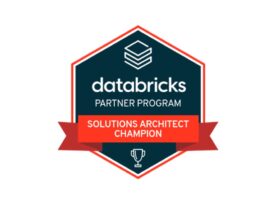Supplementing Salesforce with Databricks as an enterprise Lakehouse solution brings advantages for various personas across an organization. Customer experience data is highly valued when it comes to driving personalized customer journeys leveraging company-wide applications beyond Salesforce. From enhanced customer satisfaction to tailored engagements and offerings that drive business renewals and expansions, the advantages are hard […]
Posts Tagged ‘Databricks’
Databricks Lakebase – Database Branching in Action
What is Databricks Lakebase? Databricks Lakebase is a Postgres OLTP engine, integrated into Databricks Data Intelligence Platform. A database instance is a compute type that provides fully managed storage and compute resources for a postgres database. Lakebase leverages an architecture that separates compute and storage, which allows independent scaling while supporting low latency (<10ms) and […]
Celebrating Perficient’s Third Databricks Champion
We’re excited to welcome Bamidele James as Perficient’s newest and third Databricks Champion! His technical expertise, community engagement, advocacy, and mentorship have made a profound impact on the Databricks ecosystem. His Nomination Journey Bamidele’s journey through the nomination process was vigorous. It required evidence that he has successfully delivered multiple Databricks projects, received several certifications, […]
Unlocking Business Success with Databricks One
Business users don’t use notebooks. Full stop. And for that reason, most organizations don’t have business users accessing the Databricks UI. This has always been a fundamental flaw in Databricks’ push to democratize data and AI. This disconnect is almost enshrined in the medallion architecture: Bronze is for system accounts, data scientists with notebooks use […]
Understanding Clean Rooms: A Comparative Analysis Between Databricks and Snowflake
“Clean rooms” have emerged as a pivotal data sharing innovation with both Databricks and Snowflake providing enterprise alternatives. Clean rooms are secure environments designed to allow multiple parties to collaborate on data analysis without exposing sensitive details of data. They serve as a sandbox where participants can perform computations on shared datasets while keeping raw […]
Transforming Your Data Strategy with Databricks Apps: A New Frontier
I’ve been coding in notebooks for so long, I forgot how much I missed a nice, deployed application. I also didn’t realize how this was limiting my solution space. Then I started working with Databricks Apps. Databricks Apps are designed to extend the functionality of the Databricks platform, providing users with enriched features and capabilities […]
Exploring the Free Edition of Databricks: A Risk-Free Approach to Enterprise AI
Databricks announced a full, free version of the platform at the Data and AI Summit. While the Free Edition is targeted to students and hobbyists, I also see opportunities where enterprise architects can effectively evangelize Databricks without going through Procurement for a license. Choosing the right platform to manage, analyze, and extract insights from massive […]
Exploring Lakebase: Databricks’ Next-Gen AI-Native OLTP Database
Lakebase is Databricks‘ OLTP database and the latest member of its ML/AI offering. Databricks has incorporated various components to support its AI platform, including data components. The Feature Store has been available for some time as a governed, centralized repository that manages machine learning features throughout their lifecycle. Mosaic AI Vector Search is a vector […]
Lakeflow: Revolutionizing SCD2 Pipelines with Change Data Capture (CDC)
Several breakthrough announcements emerged at DAIS 2025, but the Lakeflow updates around building robust pipelines had the most immediate impact on my current code. Specifically, I can now see a clear path to persisting SCD2 (Slowly Changing Dimension Type 2) tables in the silver layer from mutable data sources. If this sentence resonates with you, […]
Unleashing the Power of AI Functions in Databricks SQL
By providing AI functions for SQL analysts, Databricks continues to integrate data, ML, and AI across its platform. AI Functions in Databricks SQL are pre-built, easy-to-use functions that incorporate machine learning models into SQL queries. These functions enable data analysts and engineers to leverage AI capabilities without the need for extensive machine learning expertise. By […]
LatAm’s First Databricks Champion at Perficient
We are thrilled to announce that Juan Cardona Ramirez has been recognized as a Databricks Partner Champion, making him the first Perficient colleague in Latin America to earn this prestigious designation. This recognition celebrates Juan’s deep technical expertise, consistent contributions, and commitment to innovation within the Databricks ecosystem. Program Overview The Databricks Partner Champion […]
Avoiding Metadata Contention in Unity Catalog
Metadata contention in Unity Catalog can occur in high-throughput Databricks environments, slowing down user queries and impacting performance across the platform. Our Finops strategy shifts left on performance. However, we have found scenarios where clients are still experiencing query slowdowns intermittently and even on optimized queries. As our client’s lakehouse footprint grows, we are seeing […]










